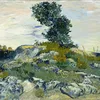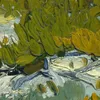



About the Artist
Master’s Palette
Reveal the unique color story behind each piece, helping you delve into the artistic essence, and spark boundless inspiration and imagination.

Bring the captivating colors to your project. Click to copy!
Artwork Story
Vincent van Gogh’s The Rocks captures the raw, untamed energy of nature with thick, swirling brushstrokes that seem to pulse with life. Jagged formations rise from the earth, their rough textures contrasted by patches of vibrant greenery and a sky alive with movement. There’s a restless quality to the painting—as if the landscape itself is breathing, shifting under the weight of van Gogh’s impassioned hand. The composition feels almost unstable, echoing the artist’s own turbulent emotions during his time in the south of France, where he sought solace in the wild beauty of the Provençal countryside.
What makes The Rocks particularly striking is its refusal to settle into stillness. Every stroke fights against calm, pulling the viewer into a world where even the earth feels volatile. Shadows deepen unexpectedly, while flecks of light dance across the scene like sparks. Van Gogh didn’t just paint a landscape; he channeled its spirit, transforming rock and soil into something almost mythological. It’s a reminder of how he saw the world—not as static, but as a force in constant, thrilling motion.


 (c. 1380-1390)-full.webp)
-full.webp)
-full.webp)
-full.webp)
-full.webp)
-full.webp)